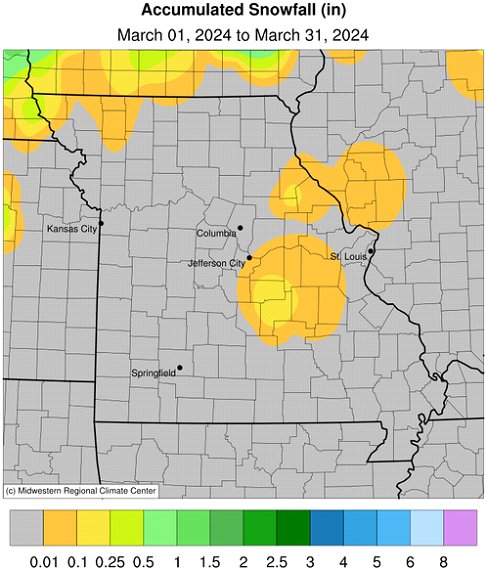
March 2024 Weather and Its Impacts on Missouri
Dr. Pat Guinan |
Dr. Zachary Leasor |
Unusually mild conditions were dominant across Missouri in March, especially during the first half of the month. More seasonable but variable temperatures occurred for the latter half of March, Figure 1. Preliminary statewide data indicate an average statewide temperature of 44.9°F, 5.0° above the long-term average, Figure 2. Nine out of the past ten Marches in Missouri have been warmer than normal and there has been only one month (Jan 2024) over the past 15 months where temperatures were below normal, Figure 3.
Preliminary precipitation data indicate the average statewide March total was 2.77 inches, or 0.44 inches below the long-term average. It was the first drier than average March since 2016, Figure 4. Most areas of the state experienced dry conditions with largest departures impacting southeastern and southwestern sections. A small portion of east central and south central Missouri reported near to above normal rainfall, where 3-5 inches were common. It was the second consecutive drier than average month; 8 out of the past 12 months have been below average, Figure 5.
There were no major winter weather events and little to no March snowfall accumulations reported statewide, Figure 6.
According to the U.S. Drought Monitor for March 26, 2024, areas of drought persisted across the state, especially over portions of northwestern, northeastern, west central and southeastern Missouri, Figure 7.
A guide to spring frost/freeze probabilities for Missouri can be accessed at the following link:
Missouri Frost Freeze Probabilities Guide
http://ipm.missouri.edu/frostfreezeguide/
The median last spring frost date is defined as the day after which there is a 50 percent chance of a light killing frost (≤ 32°F). Typically, the last spring frost occurs over northern and central Missouri by April 20 and April 10, respectively. Frosts are more likely to be experienced later in the spring over the Ozarks when compared to central Missouri. The reason for this is due to the higher elevation of the Ozark Plateau which causes cooler temperatures in the Ozark region than would be expected. Some counties in the Ozarks normally do not experience their last frost until the end of April. As the Ozark Plateau transitions to the southeastern lowlands of the Bootheel, the median last spring frost occurs around the first week of April.
Jump to:
- Figure 1
- Figure 2
- Figure 3
- Figure 4
- Figure 5
- Figure 6
- Figure 7
- Figure 8
- Figure 9
- Figure 10
- Figure 11

Figure 1.

Figure 2.

Figure 3.

Figure 4.

Figure 5.

Figure 6.

Figure 7.




Source: Dr. Pat Guinan and Dr. Zack Leasor | 573-882-5908












